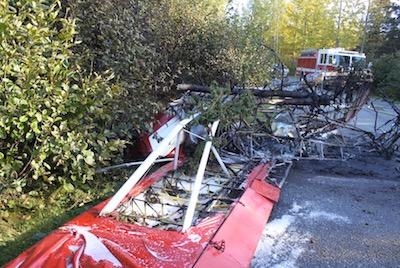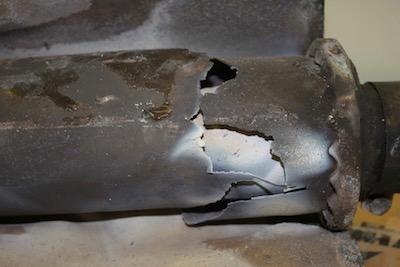Pilot Of The Experimental Float Plane Fatally Injured
The NTSB has released a factual report and opened its accident docket from an accident which occurred on September 16, 2016 involving an experimental amateur-built, Hefty Polar Cub airplane. The pilot, who was the only occupant of the aircraft, was fatally injured in the accident. Pathology indicated that he had carbon monoxide in his system.

According to the report, the flight reportedly originated in southwest Anchorage from Jewell Lake about 1500, but the actual departure time and flight route are unknown. The accident occurred at about 1630 local time.
According to family and friends of the pilot, the purpose of the flight was to fly over a proposed hunting site near Willow, Alaska, and then return to Anchorage. The friend related that the pilot and a group of friends were planning a fly-in hunt later in the week.
During on-scene interviews conducted by the National Transportation Safety Board (NTSB) investigator-in-charge (IIC) on the day of the accident, multiple witnesses consistently reported that they observed the airplane complete two, low-level, high-speed, 360° right turns over a residential neighborhood. The witnesses said that the airplane's first 360° turn was accomplished at an altitude between 150 and 200 ft above ground level, but the second turn was much lower. One homeowner stated that, as the airplane passed over his home, it was about 50 ft above his roofline. The witnesses also reported that the airplane's bank angle increased significantly on the second 360° right turn. One pilot-rated witness estimated that the airplane's bank angle was in excess of 60° during the second 360° turn. Multiple witnesses reported hearing the airplane's engine operating in a manner consistent with high power settings throughout both 360° turns.
Witnesses near the accident site reported that, as the airplane completed the second, steep, 360° right turn, the nose of the airplane pitched down, and it began a rapid nose-down descent. The engine rpm then increased significantly, and the wings rolled level just before the airplane impacted a stand of tall trees adjacent to a home. During the collision sequence, the airplane's floats were severed, and the airplane subsequently descended onto a neighborhood road, coming to rest inverted. A postimpact fire ensued about 30 seconds after impact, which quickly engulfed the entire airplane.
During a brief on scene interview with the NTSB IIC, a family member, along with a friend of the pilot, both reported that it was highly unusual and uncharacteristic behavior for the pilot to be flying as witnesses described.
The airplane, which bears a resemblance to a Piper PA-11, had a rectangular, welded steel-tube structure that was covered with fabric. The wings, rudder, and horizontal stabilizer were all fabric covered. At the time of the accident, the airplane was equipped with a set of EDO 2000- series floats.
According to archived documents on file with the FAA certification office located in Oklahoma City, the airplane was built by the pilot from a set of purchased plans and was issued an FAA experimental airworthiness certificate with operating limitations on May 22, 1996. At the time the airworthiness certificate was issued, the airplane was equipped with a Continental Motors C-90-12-F engine.
At the time of the accident, the airplane was equipped with a Lycoming O-320-A2A engine, serial number L-9126-27, and a Catto composite propeller. No installation documentation for either the engine or propeller was located. No aircraft maintenance records were located for the accident airplane. According to family members of the pilot, the airframe and engine logbooks were likely on board the airplane at the time of the accident. According to a family friend, the accident pilot performed all of the maintenance on the accident airplane.
A postmortem examination of the pilot was conducted under the authority of the Alaska State Medical Examiner, Anchorage, Alaska. The cause of death for the pilot was attributed to blunt force injuries. The autopsy also identified extensive lacerations of the aorta, heart, and liver. There was no soot identified in the tracheobronchial tree.
The FAA Bioaeronautical Sciences Research Laboratory performed toxicological examinations, which revealed 48% carboxyhemoglobin (carbon monoxide) in the pilot's blood. Additionally, amlodipine, metoprolol, naproxen, and rosuvastatin were detected in the pilot's blood and urine.
Carbon monoxide is an odorless, tasteless, colorless, nonirritating gas formed by hydrocarbon combustion. Carbon monoxide binds to hemoglobin with much greater affinity than oxygen, forming carboxyhemoglobin; elevated levels result in impaired oxygen transport and utilization. Early symptoms of carbon monoxide exposure may include headache, malaise, nausea, and dizziness. Carboxyhemoglobin levels between 10% and 20% can result in confusion, impaired judgment, and difficulty concentrating.
Nonsmokers may normally have up to 3% carboxyhemoglobin in their blood; heavy smokers may have levels of 10% to 15%. Family members and friends reported that the pilot was a nonsmoker.

On December 2, 2016, after being notified by the FAA's Bioaeronautical Sciences Research Laboratory of the elevated level of carboxyhemoglobin in the pilot's blood, the NTSB IIC recovered the accident airplane's exhaust system for a detailed examination. The airplane's exhaust system consisted of a muffler covered by an exterior shroud assembly that provided ducted heat to the airplane's cockpit, cabin, and engine carburetor heat system. During the exhaust system examination, the NTSB IIC peeled open the shroud assembly, which revealed a severely degraded and damaged muffler can assembly. The muffler can was cracked around most of its circumference near the inlet portion of the muffler. The entire muffler assembly was then sent to the NTSB's Materials Laboratory for further examination.
The examination revealed that portions of the muffler can material were missing and that areas adjacent to the missing material had white, oxidized exhaust deposits. Cracks and corrosion on the interior surface of the exterior shroud in an area under a riveted doubler were also seen. A copy of the NTSB's Materials Laboratory Factual Report is included in the public docket for this accident.
(Images from NTSB accident docket)
 Airbus Racer Helicopter Demonstrator First Flight Part of Clean Sky 2 Initiative
Airbus Racer Helicopter Demonstrator First Flight Part of Clean Sky 2 Initiative Diamond's Electric DA40 Finds Fans at Dübendorf
Diamond's Electric DA40 Finds Fans at Dübendorf ANN's Daily Aero-Term (04.23.24): Line Up And Wait (LUAW)
ANN's Daily Aero-Term (04.23.24): Line Up And Wait (LUAW) NTSB Final Report: Extra Flugzeugbau GMBH EA300/L
NTSB Final Report: Extra Flugzeugbau GMBH EA300/L Classic Aero-TV: 'Never Give Up' - Advice From Two of FedEx's Female Captains
Classic Aero-TV: 'Never Give Up' - Advice From Two of FedEx's Female Captains




